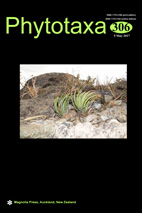Abstract
Genus Arisaema Martius (1831: 449) is represented by 215 taxa worldwide (Govaerts et al. 2017), of which 61 taxa are reported so far from India including two recent discoveries from Kerala and Tamil Nadu states of Western Ghats, viz. A. peerumedense J. Mathew in Mathew & George (2017: 29), A. madhuanum Nampy & Manudev in Manudev & Nampy (2014: 269) and A. gracilentum Bruggeman (2016: 87) from Arunachal Pradesh of North-East India. During extensive surveys in the Nilgiri Biosphere Reserve, Tamil Nadu, the authors came across two fascinating Arisaema species, one from Thia Shola and the second from Pennant’s Valley forest areas. The first species is attractive by means of its translucent spathe and the latter by its long caudate limb with a filiform thread. Detailed study of relevant literature (Fischer 1933, Fischer 1934, Gusman & Gusman 2002) confirmed their identity as A. translucens Fischer (1933: 344) and A. tuberculatum Fischer (1934: 167), respectively. Arisaema translucens is described by Fischer (1933) based on the collection from Thia Shola forests by E. Barnes at an elevation of 6000 ft made in 1932. From a thorough literature survey and herbarium consultations, it became apparent that this taxon had not been collected since 1932. Hence our discovery is a recollection of this species after a lapse of 84 years from its type locality. Detailed description, colour photographs and distribution information are provided based on the recent collections.

